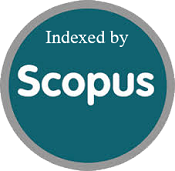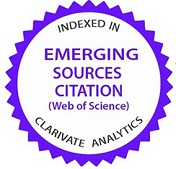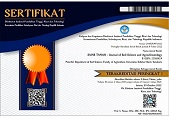Improving coffee soil health using compost made from sugarcane leaves, coffee pulp, and Gliricidia sp.
Abstract
Agricultural waste management remains a critical environmental concern, necessitating sustainable approaches to transform organic residues into valuable resources. Among these, composting offers an effective solution by converting biomass into nutrient-rich soil amendments and reducing the burden of waste disposal. This study aims to investigate the potential of combined agricultural waste composting for producing high-quality compost and enhancing soil properties in a coffee plantation. Eight composting treatments and three replications were formulated: P1: Saccharum officinarum leaves (100%), P2: Coffee pulp (100%), P3: Gliricidia sp. leaves (100%), P4: Saccharum officinarum leaves (50%) + Coffee pulp (25%) + Gliricidia sp. leaves (25%), P5: Coffee pulp (50%) + Saccharum officinarum leaves (25%) + Gliricidia sp. leaves (25%), P6: Gliricidia sp. leaves (50%) + Coffee pulp (25%) + Saccharum officinarum leaves (25%), P7: Coffee pulp (50%) + Saccharum officinarum leaves (50%), and P8: Coffee pulp (50%) + Gliricidia sp. leaves (50%). The findings indicated that the compost mixtures containing Gliricidia sp. leaves and coffee pulp yielded a C:N ratio of less than 25, signifying that the compost was mature. The application of compost resulted in an overall increase in soil pH, organic carbon, and total nitrogen, while also ameliorating soil structure through reduced bulk density and enhanced porosity, particularly at a depth of 30–60 cm. These results provide valuable insights for farmers and agricultural policymakers in developing sustainable waste management strategies that effectively address agricultural waste disposal challenges while improving soil fertility and promoting more environmentally friendly coffee production systems.
Keywords
Full Text:
PDFReferences
Akoto, D. S., Partey, S. T., Abugre, S., Akoto, S., Denich, M., Borgemeister, C., & Schmitt, C. B. (2022). Comparative analysis of leaf litter decomposition and nutrient release patterns of bamboo and traditional species in agroforestry system in Ghana. Cleaner Materials, 4, 100068. https://doi.org/10.1016/j.clema.2022.100068
Azim, K., Soudi, B., Boukhari, S., Perissol, C., Roussos, S., & Thami Alami, I. (2018). Composting parameters and compost quality: a literature review. Organic Agriculture, 8(2), 141-158. https://doi.org/10.1007/s13165-017-0180-z
Batubara, R. P., & Listyarini, E. (2017). Kajian Aplikasi Seresah Testjbu dan Urea terhadap Ketersedian Nitrogen dalam Tanah PT. Perkebunan Nusantara X Jengkol-Kediri. Jurnal Tanah dan Sumberdaya Lahan, 4(1), 411-419. https://jtsl.ub.ac.id/index.php/jtsl/article/view/155
Bhuvaneshwari, S., Hettiarachchi, H., & Meegoda, J. N. (2019). Crop Residue Burning in India: Policy Challenges and Potential Solutions. International Journal of Environmental Research and Public Health, 16(5), 832. https://doi.org/10.3390/ijerph16050832
Biyada, S., Merzouki, M., Dėmčėnko, T., Vasiliauskienė, D., Ivanec-Goranina, R., Urbonavičius, J., . . . Benlemlih, M. (2021). Microbial community dynamics in the mesophilic and thermophilic phases of textile waste composting identified through next-generation sequencing. Scientific Reports, 11(1), 23624. https://doi.org/10.1038/s41598-021-03191-1
Bohacz, J. (2019). Changes in mineral forms of nitrogen and sulfur and enzymatic activities during composting of lignocellulosic waste and chicken feathers. Environmental Science and Pollution Research, 26(10), 10333-10342. https://doi.org/10.1007/s11356-019-04453-2
Boutasknit, A., Baslam, M., Ait-El-Mokhtar, M., Anli, M., Ben-Laouane, R., Ait-Rahou, Y., . . . Meddich, A. (2021). Assemblage of indigenous arbuscular mycorrhizal fungi and green waste compost enhance drought stress tolerance in carob (Ceratonia siliqua L.) trees. Scientific Reports, 11(1), 22835. https://doi.org/10.1038/s41598-021-02018-3
BPS. (2023). Kabupaten Malang Dalam Angka 2023. Badan Pusat Statistik(BPS - Statistics Indonesia) of Malang Regency. https://malangkab.bps.go.id/id/publication/2023/02/28/a35c692e3195f7d33b17464e/kabupaten-malang-dalam-angka-2023.html
Dadi, D., Daba, G., Beyene, A., Luis, P., & Van der Bruggen, B. (2019). Composting and co-composting of coffee husk and pulp with source-separated municipal solid waste: a breakthrough in valorization of coffee waste. International Journal of Recycling of Organic Waste in Agriculture, 8(3), 263-277. https://doi.org/10.1007/s40093-019-0256-8
Danapriatna, N., Ismarani, Luthifadi, R., & Dede, M. (2023). Effect of straw compost (Oryza sativa L.) on crop production. PERTANIKA JOURNAL OF TROPICAL AGRICULTURAL SCIENCE, 46(3), 1047-1062. https://doi.org/10.47836/pjtas.46.3.17
Domínguez, M., Paradelo Núñez, R., Piñeiro, J., & Barral, M. T. (2019). Physicochemical and biochemical properties of an acid soil under potato culture amended with municipal solid waste compost. International Journal of Recycling of Organic Waste in Agriculture, 8(2). https://doi.org/10.1007/s40093-019-0246-x
Dotaniya, M. L., Datta, S. C., Biswas, D. R., Dotaniya, C. K., Meena, B. L., Rajendiran, S., . . . Lata, M. (2016). Use of sugarcane industrial by-products for improving sugarcane productivity and soil health. International Journal of Recycling of Organic Waste in Agriculture, 5(3). https://doi.org/10.1007/s40093-016-0132-8
Du, R., Cui, L., Feng, Y., Lv, X., Gao, Y., Li, A., . . . Ma, Y. (2025). Enhancing the decomposition and composting of food waste by in situ directional enzymatic hydrolysis: performance, ARGs removal and engineering application. Waste Management, 200, 114774. https://doi.org/10.1016/j.wasman.2025.114774
Ejigu, W., G.Selassie, Y., Elias, E., & Damte, M. (2021). Integrated fertilizer application improves soil properties and maize (Zea mays L.) yield on Nitisols in Northwestern Ethiopia. Heliyon, 7(2), e06074. https://doi.org/10.1016/j.heliyon.2021.e06074
Farni, Y., Prijono, S., Suntari, R., & Handayanto, E. (2022). Pattern of N mineralization and nutrient uptake of Tithonia diversifolia and Saccharum officinarum leaves in sandy loam soil. Indian Journal of Agricultural Research, 56(1), 65-69. https://doi.org/10.18805/IJARe.A-626
Gao, X., Tan, W., Zhao, Y., Wu, J., Sun, Q., Qi, H., . . . Wei, Z. (2019). Diversity in the Mechanisms of Humin Formation during Composting with Different Materials. Environmental Science & Technology, 53(7), 3653-3662. https://doi.org/10.1021/acs.est.8b06401
Gnanamani, K., & Vijayalakhsmi, A. (2023). Effect of composted sugarcane trash and bagasse on the growth and yield of tomato (Solanum lycopersicum L.). Agricultural Science Digest-A Research Journal, 43(3), 269-273. https://doi.org/10.18805/ag.D-5632.
Hoseini, M., Cocco, S., Casucci, C., Cardelli, V., & Corti, G. (2021). Coffee by-products derived resources. A review. Biomass and Bioenergy, 148, 106009. https://doi.org/10.1016/j.biombioe.2021.106009
ICO. (2023). Coffee Development Report 2023. International Coffee Organization. https://ico.org/coffee-development-report-2/
Ishangulyyev, R., Kim, S., & Lee, S. H. (2019). Understanding Food Loss and Waste—Why Are We Losing and Wasting Food? Foods, 8(8), 297. https://doi.org/10.3390/foods8080297
Jain, M. S., & Kalamdhad, A. S. (2020). Soil revitalization via waste utilization: Compost effects on soil organic properties, nutritional, sorption and physical properties. Environmental Technology & Innovation, 18, 100668. https://doi.org/10.1016/j.eti.2020.100668
Kok, D.-J. D., Scherer, L., de Vries, W., & van Bodegom, P. M. (2023). Temporal variability in organic amendment impacts on hydro-physical properties of sandy agricultural soils. Soil Science Society of America Journal, 87(4), 963-984. https://doi.org/10.1002/saj2.20547
Koul, B., Yakoob, M., & Shah, M. P. (2022). Agricultural waste management strategies for environmental sustainability. Environmental Research, 206, 112285. https://doi.org/10.1016/j.envres.2021.112285
Kulandaivelu, V., & Bhat, R. (2012). Changes in the physico-chemical and biological quality attributes of soil following amendment with untreated coffee processing wastewater. European Journal of Soil Biology, 50, 39-43. https://doi.org/10.1016/j.ejsobi.2011.11.011
Kumar, M., Upadhyay, S. N., & Mishra, P. K. (2022). Pyrolysis of Sugarcane (Saccharum officinarum L.) Leaves and Characterization of Products. ACS Omega, 7(32), 28052-28064. https://doi.org/10.1021/acsomega.2c02076
Lazicki, P., Geisseler, D., & Lloyd, M. (2020). Nitrogen mineralization from organic amendments is variable but predictable. Journal of Environmental Quality, 49(2), 483-495. https://doi.org/10.1002/jeq2.20030
Li, F., Liang, X., Li, H., Jin, Y., Jin, J., He, M., . . . Bol, R. (2020). Enhanced soil aggregate stability limits colloidal phosphorus loss potentials in agricultural systems. Environmental Sciences Europe, 32(1), 17. https://doi.org/10.1186/s12302-020-0299-5
Liu, D., Ding, Z., Ali, E. F., Kheir, A. M. S., Eissa, M. A., & Ibrahim, O. H. M. (2021). Biochar and compost enhance soil quality and growth of roselle (Hibiscus sabdariffa L.) under saline conditions. Scientific Reports, 11(1), 8739. https://doi.org/10.1038/s41598-021-88293-6
Liu, X., Liu, J., Huang, J., Chen, Y., Zhang, L., Qi, Y., . . . Zhu, Y. (2023). Response of Soil Aggregate Stability to Phosphorus, Nitrogen, and Organic Fertilizer Addition: A Meta-Analysis. Sustainability, 15(13), 10601. https://doi.org/10.3390/su151310601
Ma, C., Lo, P. K., Xu, J., Li, M., Jiang, Z., Li, G., . . . Li, Q. (2020). Molecular mechanisms underlying lignocellulose degradation and antibiotic resistance genes removal revealed via metagenomics analysis during different agricultural wastes composting. Bioresource Technology, 314, 123731. https://doi.org/10.1016/j.biortech.2020.123731
Macias-Corral, M. A., Cueto-Wong, J. A., Morán‑Martínez, J., & Reynoso‑Cuevas, L. (2019). Effect of different initial C/N ratio of cow manure and straw on microbial quality of compost. International Journal of Recycling of Organic Waste in Agriculture, 8(4). https://doi.org/10.1007/s40093-019-00308-5
Medina Litardo, R. C., García Bendezú, S. J., Carrillo Zenteno, M. D., Pérez-Almeida, I. B., Parismoreno, L. L., & Lombeida García, E. D. (2022). Effect of mineral and organic amendments on rice growth and yield in saline soils. Journal of the Saudi Society of Agricultural Sciences, 21(1), 29-37. https://doi.org/10.1016/j.jssas.2021.06.015
Meng, L., Li, W., Zhang, S., Zhang, X., Zhao, Y., & Chen, L. (2021). Improving sewage sludge compost process and quality by carbon sources addition. Scientific Reports, 11(1), 1319. https://doi.org/10.1038/s41598-020-79443-3
Meng, Q., Yang, W., Men, M., Bello, A., Xu, X., Xu, B., . . . Zhu, H. (2019). Microbial Community Succession and Response to Environmental Variables During Cow Manure and Corn Straw Composting. Frontiers in Microbiology, Volume 10 - 2019. https://doi.org/10.3389/fmicb.2019.00529
Mukhopadhyay, R., Sarkar, B., Jat, H. S., Sharma, P. C., & Bolan, N. S. (2021). Soil salinity under climate change: Challenges for sustainable agriculture and food security. Journal of Environmental Management, 280, 111736. https://doi.org/10.1016/j.jenvman.2020.111736
Muluneh, M. G. (2021). Impact of climate change on biodiversity and food security: a global perspective—a review article. Agriculture & Food Security, 10(1), 36. https://doi.org/10.1186/s40066-021-00318-5
Nemet, F., Perić, K., & Lončarić, Z. (2021). Microbiological activities in the composting process – A review. COLUMELLA – Journal of Agricultural and Environmental Sciences, 8(2), 41-53. https://doi.org/10.18380/SZIE.COLUM.2021.8.2.41
Neugebauer, M., Sołowiej, P., Piechocki, J., Czekała, W., & Janczak, D. (2017). The influence of the C: N ratio on the composting rate. International Journal of Smart Grid and Clean Energy, 6(1), 54-60. https://doi.org/10.12720/sgce.6.1.54-60
Nguyen, D. V., Duong, C. T. T., Vu, C. N. M., Nguyen, H. M., Pham, T. T., Tran-Thuy, T.-M., & Nguyen, L. Q. (2023). Data on chemical composition of coffee husks and lignin microparticles as their extracted product. Data in Brief, 51, 109781. https://doi.org/10.1016/j.dib.2023.109781
Okereafor, U., Makhatha, M., Mekuto, L., Uche-Okereafor, N., Sebola, T., & Mavumengwana, V. (2020). Toxic Metal Implications on Agricultural Soils, Plants, Animals, Aquatic life and Human Health. International Journal of Environmental Research and Public Health, 17(7), 2204. https://doi.org/10.3390/ijerph17072204
Rahayu, R., Syamsiyah, J., Sa, #039, & diyah, L. N. (2020). Aggregate stability of Alfisols root zone upon turfgrass treatment. Sains Tanah Journal of Soil Science and Agroclimatology, 17(1), 7. https://doi.org/10.20961/stjssa.v17i1.40455
Risdawati, N., & Soemarno, S. (2021). Pengaruh Aplikasi Kompos Kulit Buah Kopi terhadap Kandungan Bahan Organik dan Fosfor pada Inceptisol Kebun Kopi Desa Bangelan, Malang. Jurnal Tanah dan Sumberdaya Lahan, 8(2), 461-469. https://doi.org/10.21776/ub.jtsl.2021.008.2.17
Salman, M., Inamullah, Jamal, A., Mihoub, A., Saeed, M. F., Radicetti, E., . . . Pampana, S. (2023). Composting Sugarcane Filter Mud with Different Sources Differently Benefits Sweet Maize. Agronomy, 13(3), 748. https://doi.org/10.3390/agronomy13030748
Showler, A. T. (2023). Mulched and soil-incorporated sugarcane greenchop residue and compost: effects on selected soil components, sugarcane nutrients, Mexican rice borer injury, and yield. Environmental Systems Research, 12(1), 4. https://doi.org/10.1186/s40068-023-00284-w
Singh, M., Jaswal, A., Sarkar, S., & Singh, A. (2024). Influence of Integrated Use of Organic Manures and Inorganic Fertilizers on Physio-chemical Properties of Soil and Yield of Kharif Maize in Coarse Loamy Typic Haplustept Soil. Indian Journal of Agricultural Research, 58(4). https://doi.org/10.18805/IJARe.A-6034
Sitthikitpanya, N., Sittijunda, S., Khamtib, S., & Reungsang, A. (2021). Co-generation of biohydrogen and biochemicals from co-digestion of Chlorella sp. biomass hydrolysate with sugarcane leaf hydrolysate in an integrated circular biorefinery concept. Biotechnology for Biofuels, 14(1), 197. https://doi.org/10.1186/s13068-021-02041-6
Srivastava, R. K., Shetti, N. P., Reddy, K. R., Kwon, E. E., Nadagouda, M. N., & Aminabhavi, T. M. (2021). Biomass utilization and production of biofuels from carbon neutral materials. Environmental Pollution, 276, 116731. https://doi.org/10.1016/j.envpol.2021.116731
Sukphun, P., Ponuansri, C., Wongarmat, W., Sittijunda, S., Promnuan, K., & Reungsang, A. (2023). Advancing Energy Recovery from Sugarcane Leaf via Two-Stage Anaerobic Digestion for Hydrogen and Methane Production: Impacts on Greenhouse Gas Mitigation and Sustainable Energy Production. Energies, 16(23), 7861. https://doi.org/10.3390/en16237861
Susilowati, L. E., Sukartono, S., Akbar, M. F., Kusumo, B. H., Suriadi, A., Leksono, A. S., & Fahrudin, F. (2024). Assessing the synergistic effects of inorganic, organic, and biofertilizers on rhizosphere properties and yield of maize. Sains Tanah Journal of Soil Science and Agroclimatology, 21(1), 13. https://doi.org/10.20961/stjssa.v21i1.85373
Tyasmoro, S. Y., & Saitama, A. (2024). Acceleration of Organic Compost Supply Using Microbial Consortium Formulation on Various Organic Wastes and their Effect on Sweet Corn: Acceleration of Organic Compost Supply Using Microbial Consortium Formulation. Journal of Tropical Life Science, 14(2), 319-330. https://doi.org/10.11594/jtls.14.02.12
Vignozzi, N., Andrenelli, M. C., Agnelli, A. E., Fiore, A., & Pellegrini, S. (2023). Short-Term Effect of Different Inputs of Organic Amendments from Olive Oil Industry By-Products on Soil Organic Carbon and Physical Properties. Land, 12(8), 1628. https://doi.org/10.3390/land12081628
Wang, D., Lin, J. Y., Sayre, J. M., Schmidt, R., Fonte, S. J., Rodrigues, J. L. M., & Scow, K. M. (2022). Compost amendment maintains soil structure and carbon storage by increasing available carbon and microbial biomass in agricultural soil – A six-year field study. Geoderma, 427, 116117. https://doi.org/10.1016/j.geoderma.2022.116117
Wang, Y., Liu, S., Xue, W., Guo, H., Li, X., Zou, G., . . . Dong, H. (2019). The Characteristics of Carbon, Nitrogen and Sulfur Transformation During Cattle Manure Composting—Based on Different Aeration Strategies. International Journal of Environmental Research and Public Health, 16(20), 3930. https://doi.org/10.3390/ijerph16203930
Zhang, J., Ying, Y., Yao, X., Huang, W., & Tao, X. (2020). Degradations of tannin and saponin and changes in nutrition during co-composting of shell and seed cake of Camellia oleifera Abel. BioResources, 15(2), 2721. https://doi.org/10.15376/biores.15.2.2721-2734
Zhang, L., Li, L., Pan, X., Shi, Z., Feng, X., Gong, B., . . . Wang, L. (2018). Enhanced Growth and Activities of the Dominant Functional Microbiota of Chicken Manure Composts in the Presence of Maize Straw. Frontiers in Microbiology, Volume 9 - 2018. https://doi.org/10.3389/fmicb.2018.01131
Zhang, Y., Yuan, S., Gao, W., Luan, H., Tang, J., Li, R., . . . Huang, S. (2025). Long-term manure and/or straw substitution mediates phosphorus species and the phosphorus-solubilizing microorganism community in soil aggregation. Agriculture, Ecosystems & Environment, 378, 109323. https://doi.org/10.1016/j.agee.2024.109323
Refbacks
- There are currently no refbacks.











.png)





